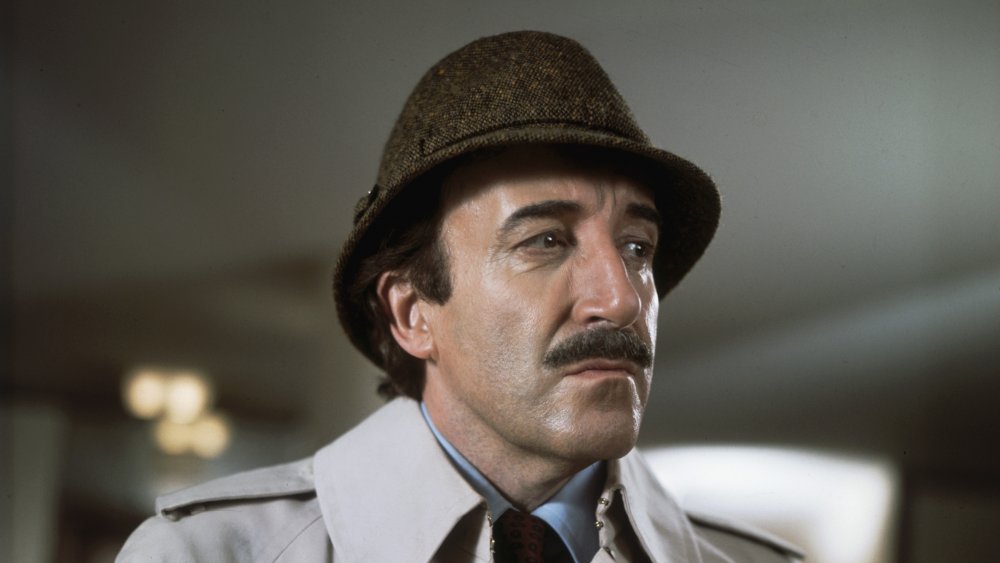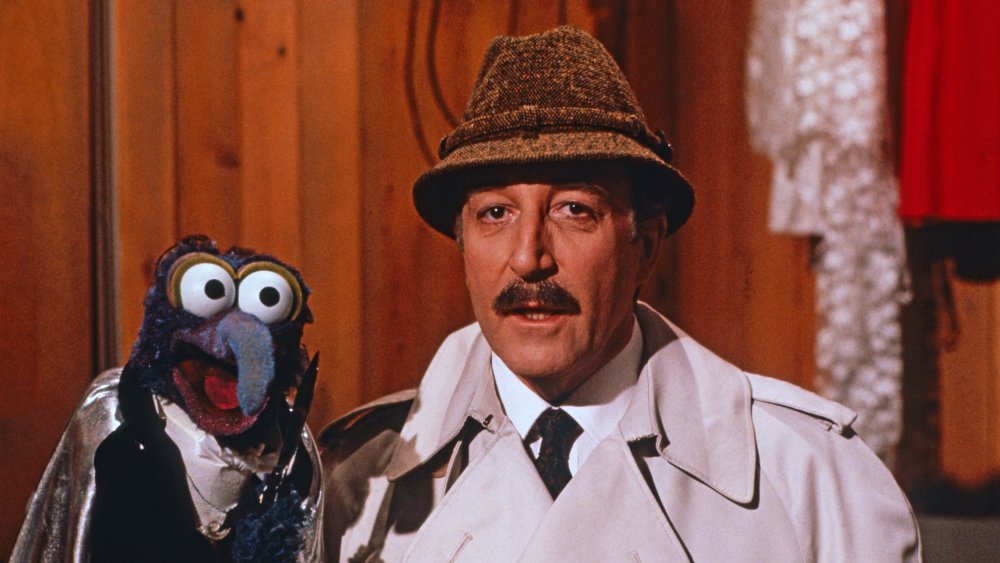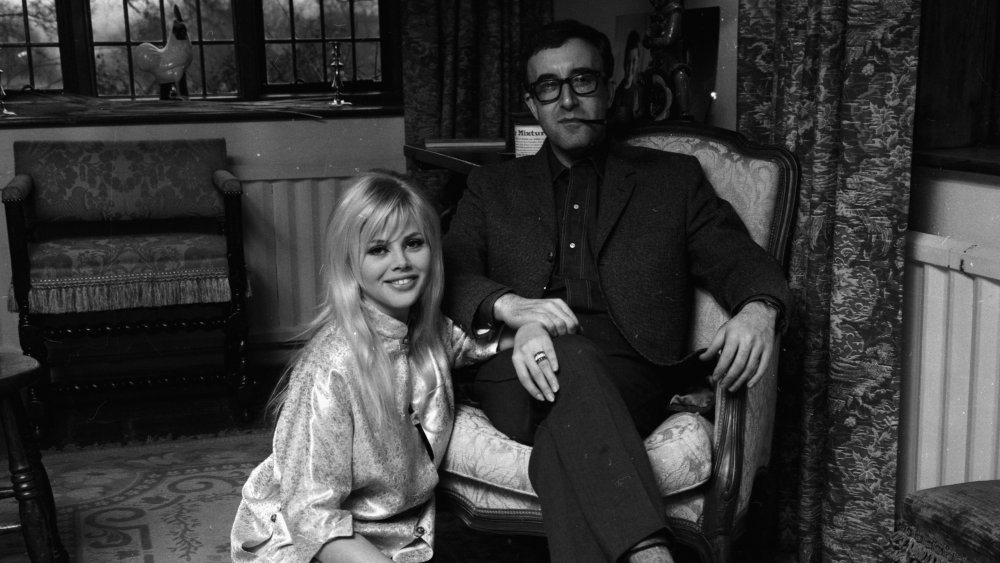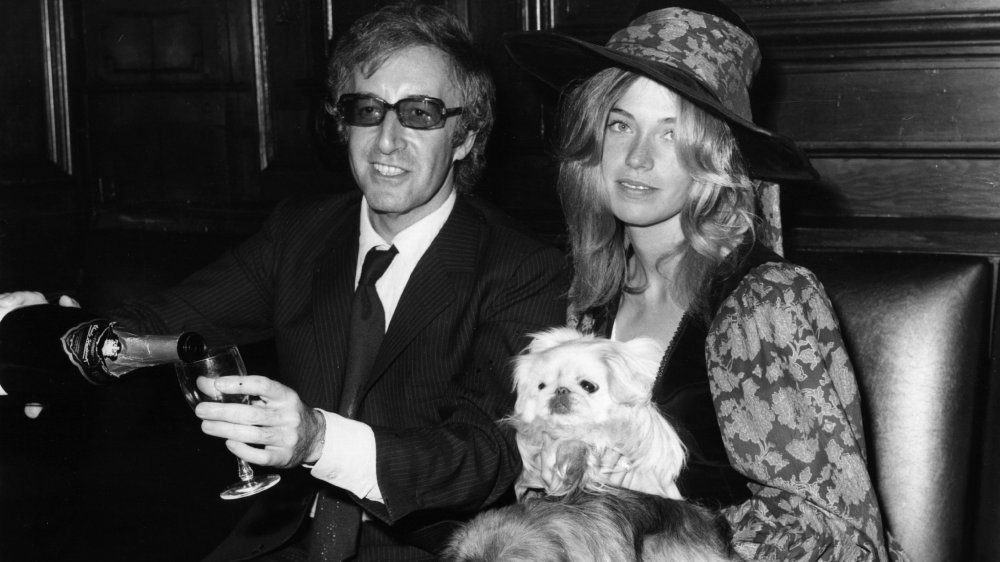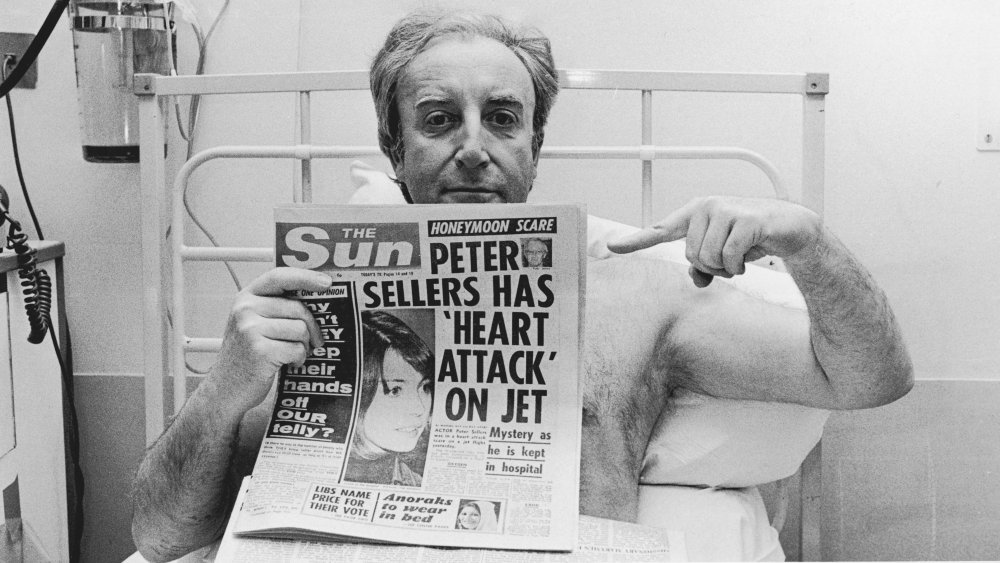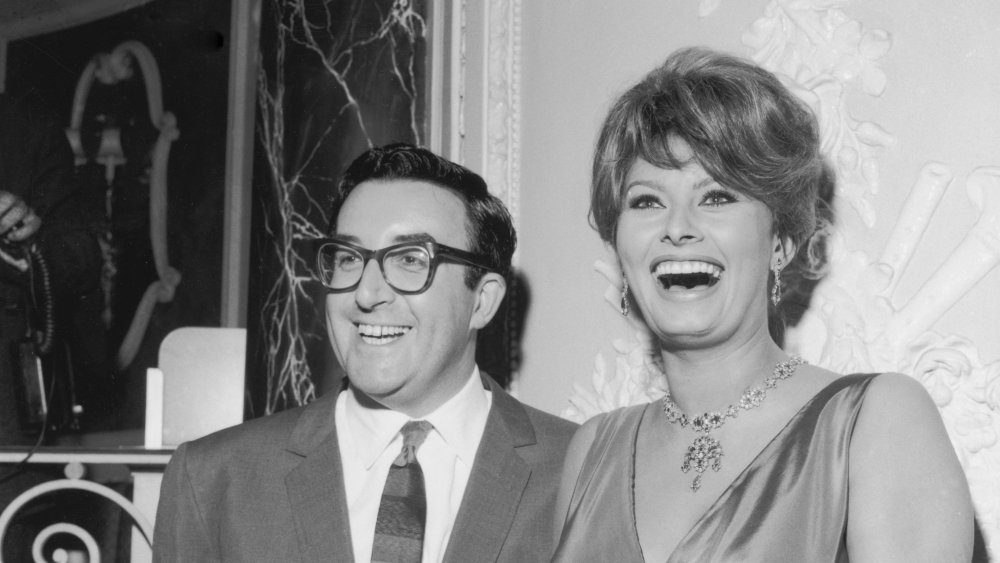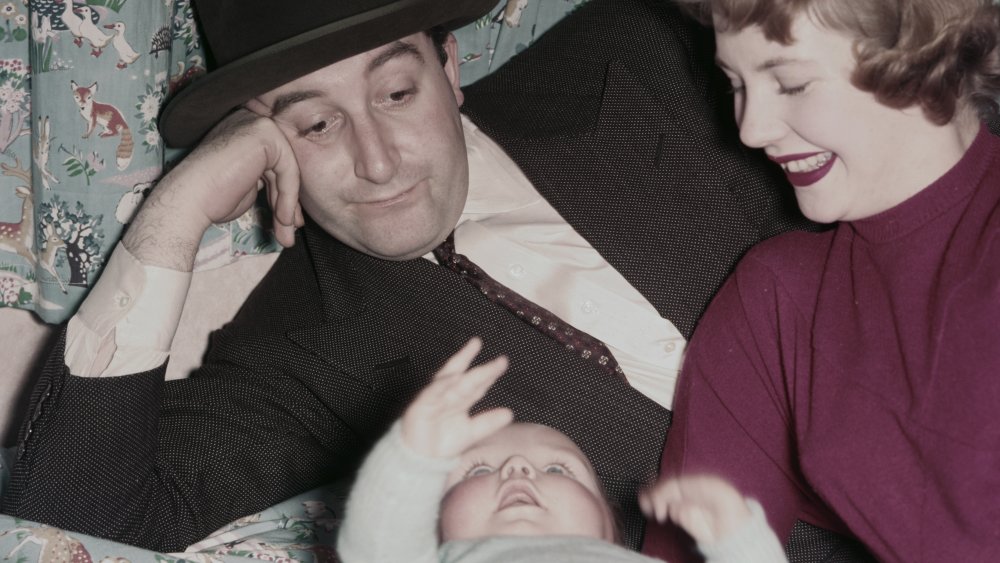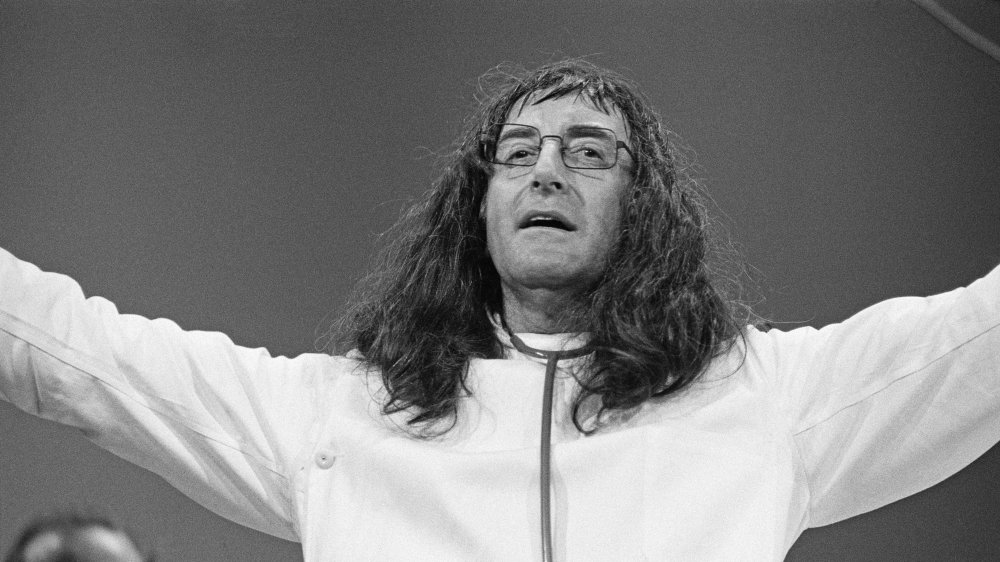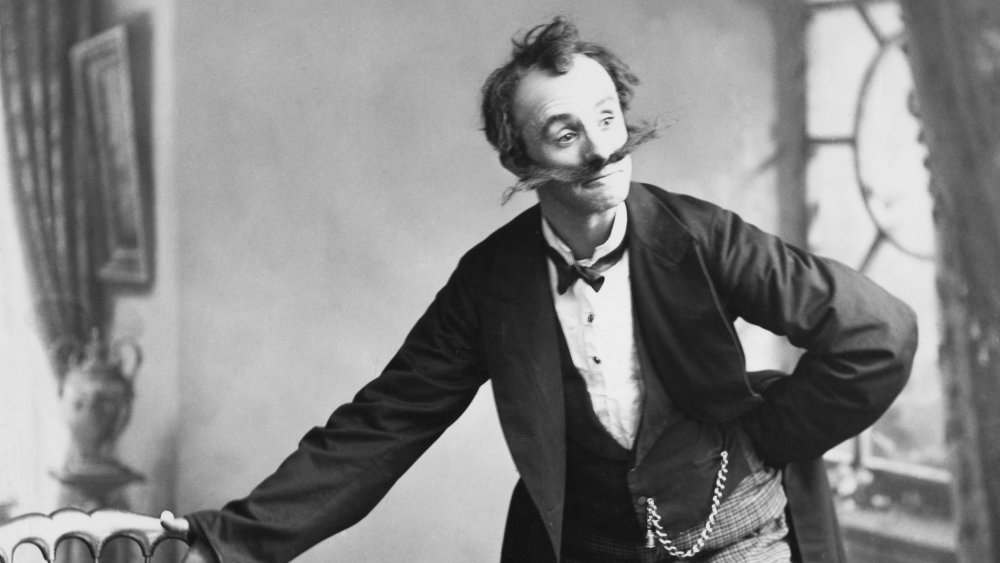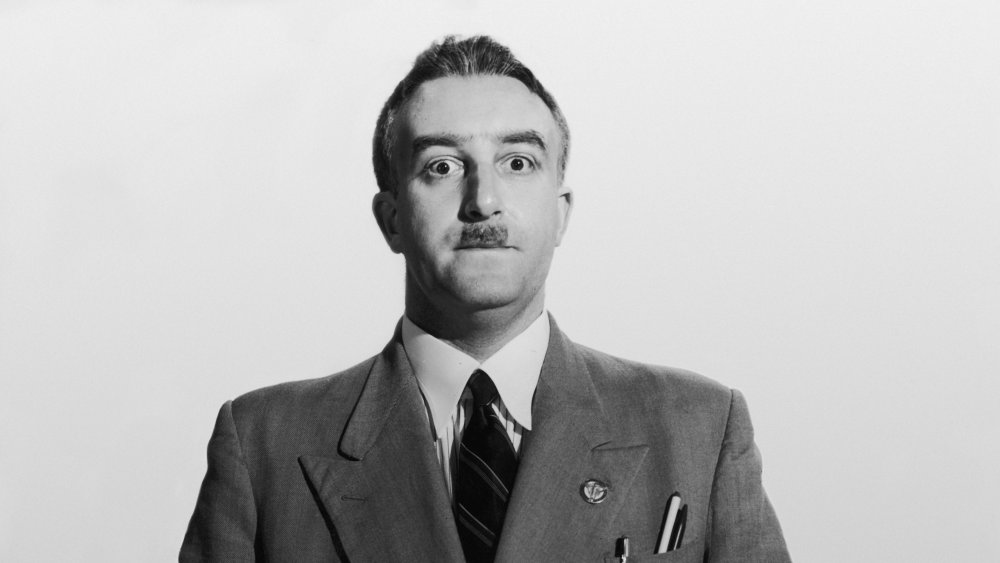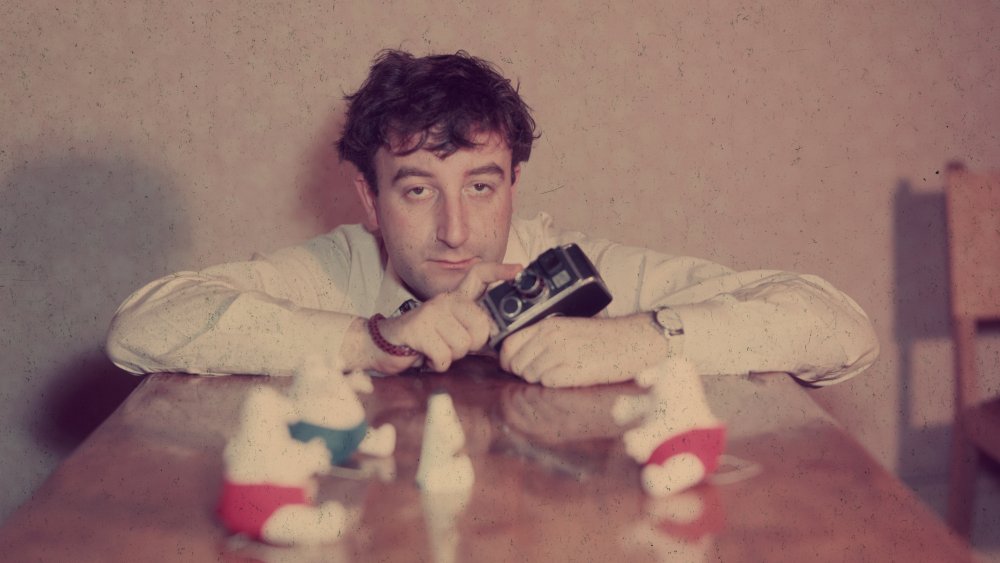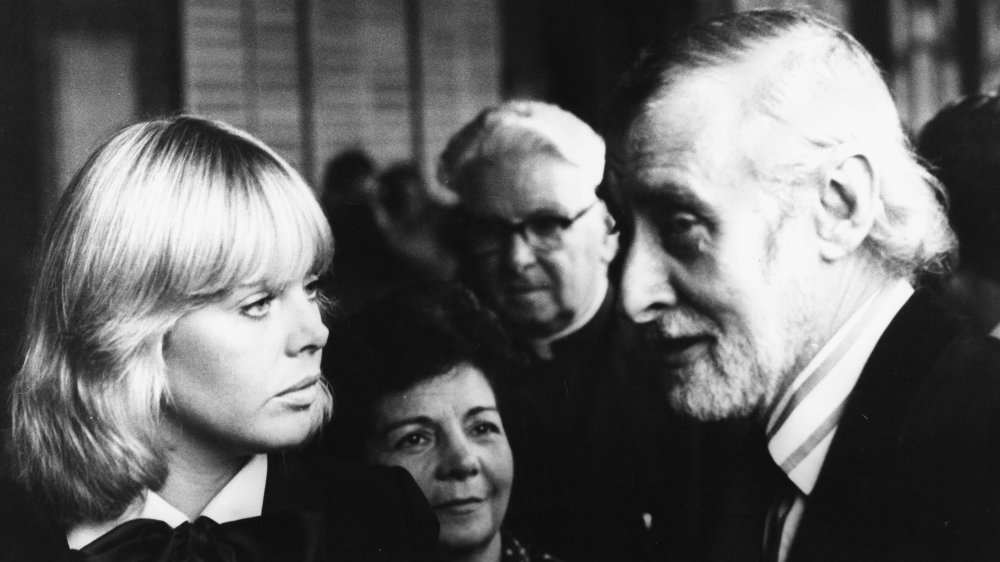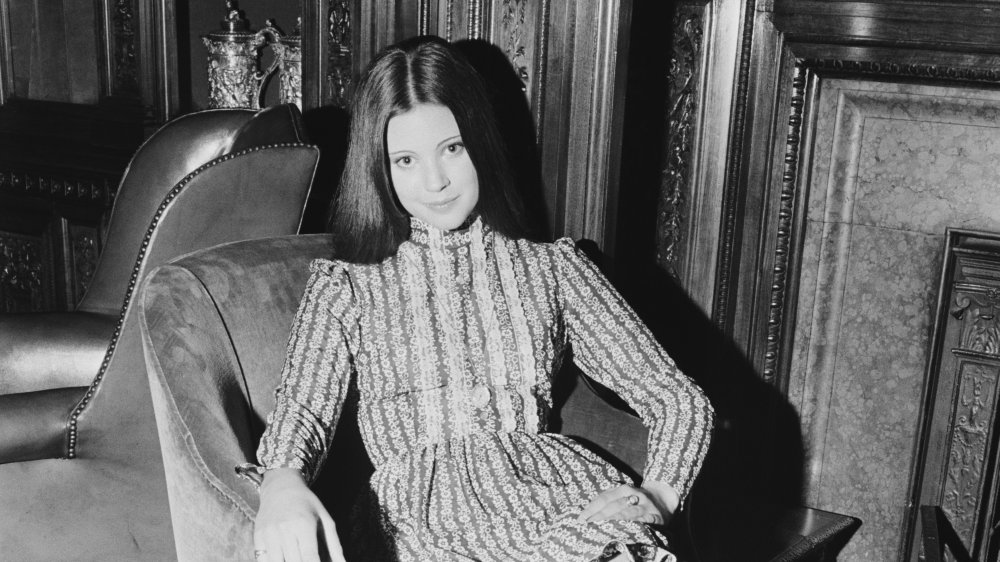Tragic Details About Peter Sellers
The life of Peter Sellers is a 20th-century archetype, that of an astronomical rise from humble beginnings to international stardom. Born into a vaudeville family — though the stage initially terrified him as a child — and doggedly working in British light entertainment live and then on the radio, the brilliance of Sellers' impressions and comic creations seemed to make his ascension to comic royalty almost inevitable.
From the BBC's The Goon Show to roles in Stanley Kubrick's Lolita and Dr. Strangelove, from the box office-smashing Pink Panther franchise to the Academy Award-nominated Being There, Sellers inhabited a range of diverse roles that have burned their way into the collective psyche of comedy and movie lovers ever since. But away from the characters of Inspector Clouseau or Chance the Gardener, Sellers was a complicated and — it has to be said — difficult man whose behavior could put great stress on those around him and, ultimately, himself.
Peter Sellers died young, and in the decades since his passing, debate about his character and behavior has rarely ceased, with a great number of well-researched biographies and a big-budget movie, The Life and Death of Peter Sellers, trying to get a grip on the reverse side of this most gifted creator of characters, to show something of the real man behind the mask. What can be found there may surprise you.
Peter Sellers claimed not to have a personality
Famous for slipping in and out of characters and creating new ones at the drop of a hat, the character of the real-life Peter Sellers has been difficult to pin down. Stanley Kubrick described the naturalness with which he inhabited roles in his classic movies as "a state of comic ecstasy," according to Den of Geek, and his dynamism is shown especially in Dr. Strangelove, in which Sellers played three distinct parts.
But it has been reported by many biographers that Sellers found his own identity impossible to inhabit, and in a 1980 interview on The Today Show, he discussed an idea that had recently taken hold that, in essence, there was no "Peter Sellers." Sellers claimed that it "isn't quite true" that, behind the mask, he was an empty vessel. But the topic had recurred throughout his career, and in a famous clip from The Muppet Show, Sellers, who had hosted the show as a range of characters, told Kermit: "There is no me. I had it surgically removed."
The Daily Telegraph notes, however, that the roots of this "selflessness" may have arisen in tragic circumstances in early childhood: Sellers was born Richard Henry Sellers, with the name "Peter" bestowed on him as a tribute to his older brother, who was stillborn. This sense of displaced identity haunted Sellers, but perhaps it gave him his ability to project himself so uncannily into the minds of other characters.
Peter Sellers was (unhappily) married four times
Peter Sellers had a reputation as a womanizer, divorcing his first wife, Anne, with whom he had had two children, in the early 1960s. His second wife, the Swedish actress Britt Ekland (pictured above with Sellers), has, in recent years, gone on record to describe their difficult marriage and Sellers' jealous, controlling, and abusive behavior, according to The Guardian. Eckland suggested that her former husband most likely had bipolar disorder, explaining the great bouts of depression and paranoia that characterized his relationships with the women in his life.
Ekland was just 21 when she met Sellers, who was 17 years her senior. The actor had seen her photograph in a newspaper and decided that "[he] would like to meet what [he] saw." The pair were soon married, with Sellers informing the press of his intentions before actually proposing to Ekland. Ekland described how Sellers would decide on almost all aspects of their lives together, including the outfits that his wife was to wear. In one incident, his abrupt decision that they should take a spontaneous holiday meant that Ekland was fired from her role in a Hollywood movie. Ekland has described how Sellers was both psychologically and physically abusive and would throw items and destroy property if he didn't get his way.
After his divorce from Ekland, Sellers remarried twice more: to aristocrat Miranda McMillan (Quarry) and later to actress Lynne Frederick, to whom he was married at the time of his death.
Peter Sellers was dependent on both alcohol and cocaine
Peter Sellers' erratic behavior toward those close to him was exacerbated by alcohol and the drugs with which he used to experiment, according to The Daily Telegraph.
Big-drinking and fast-living Hollywood actors weren't exactly a rare species in the '60s and '70s, but the effects of such a lifestyle for Sellers and those around him were especially disastrous. Firstly, alcohol and drugs affected his health dramatically, with Sellers having his first heart attack before the age of 40, according to Roger Ebert, but to make matters worse, Sellers wasn't given adequate treatment for a variety of reasons. As noted by The Guardian, Sellers' value to the production companies that made his movies meant that his heart issues were continually brushed off. On top of that, Sellers himself was highly superstitious, as reported by The Scotsman, and pursued a number of alternative methods when decisive medical intervention by pulmonary specialists might have had a tangible effect on his health.
Coupled with the fact that Sellers did not change his lifestyle — which was amplified by the similar habits of his fourth wife, Lynne Frederick — it became a certainty that his health would continue to decline.
Peter Sellers' odyssey of heart attacks
The harrowing period which his biographer Ed Sikov describes as "Peter Sellers's deaths" began in a Los Angeles hotel room in April 1964, with Sellers in bed with Britt Ekland, his 21-year-old wife whom he had married just two months prior.
Sikov's book features direct quotes from Ekland, who described the regularity with which the couple used drugs to increase their bedroom performance, particularly amyl nitrite — commonly known as "poppers." The couple would take the drug "nightly," according to Ekland, in pursuit of "the ultimate orgasm." On this particular night, however, their adventurousness would go awry, with Ekland describing how she came back from the bathroom to find Sellers collapsed on the bed in a puddle of spilled champagne, with Sellers himself realizing that he was having a heart attack.
Despite this, Sellers wasn't taken to the Cedars of Lebanon hospital until the next morning, where, over the course of the coming days, he would suffer a barrage of further heart attacks in which his heart stopped entirely. The star was revived each time by a defibrillator. Sikov describes how, on hearing the news, television crews were already working on potential obituaries. Meanwhile, between bouts of unconsciousness, Sellers performed songs and impersonations for children on the ward. Sellers would continue to have heart issues for the rest of his life.
Peter Sellers was delusionally in love with Sophia Loren
Sellers' first marriage, to Anne Howe, came to an end due to his infatuation with another woman — Italian page and screen idol Sophia Loren. Sellers and Loren had worked together on the 1960 movie The Millionairess, according to The Guardian, as well as the novelty song "Goodness Gracious Me," which Sellers performed in character — in an Indian accent — to promote the movie.
Sellers didn't exactly keep his infatuation with his co-star secret. According to Sikov, colleagues on the set of The Millionairess reported that Sellers acted boyishly toward Loren as though she were a pin-up in his bedroom, while in the evenings, over dinner with his family, the actor could not help but pore over the details of Loren's behavior and how she had treated him each day. In one incident, Sellers returned home and declared his love for Loren openly to his wife.
Loren was married to Italian movie producer Carlo Ponti — and would continue to be until his death in 2007. Sellers claimed to friends that he and his co-star were in the throes of a passionate love affair and that she was going to leave her husband for him. However, there is no evidence to support these claims, and as Michael Sellers has discussed, the possibility exists that Sellers' infatuation was nothing more than a fantasy, borne out of the inflation of his ego from being cast opposite such a glamorous sex symbol.
Peter Sellers had a strained relationship with his children
It wasn't just his first wife, Anne, who had to deal with Sellers' ego-driven emotional problems. His declaration of love for Sophia Loren also occurred in front of his children, and his son, Michael, speaking to Sikov, described a moment when his father awoke him in the night to ask him the following question: "Do you think I should divorce your mummy?"
Though the Sophia Loren saga is perhaps the most striking example of Sellers' strange lack of regard for the feelings of his family, the truth is that they acted as a continual outlet for his insecurities. In an interview with The Scotsman, Michael recalls how his father had asked him, at the age of seven, which of his parents he liked best. When he replied "Mummy," it sent Sellers into a rage. The following year, Michael says, his father wrote him a letter claiming to disown him and advising the child to take his mother's maiden name: Howe.
Michael, together with his sisters Sarah and Victoria, later wrote a bestselling book about the treatment they received from their troubled and troubling father. But aside from the intermittent contact, distance, and mood swings that the three had to contend with, the most brutal treatment was to come at the time of Peter's death.
Peter Sellers became dependent on a psychic
In both his memoir and his interview with The Scotsman, Michael Sellers recounts in detail one of the stranger aspects of his father's behavior: his relentless superstition and belief in the paranormal.
Considered by many of his biographers as a symptom of his neurotic need to control what happened around him, Sellers's superstitious nature took many forms. Most of these are familiar and harmless (avoiding walking under ladders, for example) but his growing obsession with all things occult became a problem both personally and professionally when he began to rely on horoscopes, fortune-telling, and psychic readings to make important life decisions.
Ed Sikov describes how, as early as 1958, Sellers was speaking to a clairvoyant, Maurice Woodruff, every morning to receive readings. One piece of advice he received — that a film producer would offer him a movie — seems, perhaps, an obvious prediction for an actor looking to break into Hollywood films. But the "reading" meant that Sellers would sign up for the very next part he was offered. He signed onto the 1959 movie The Mouse That Roared, though it was only an independent project, and Walter Shenson, the producer, was a first-timer. Such methods of decision-making continued to determine the trajectory of Sellers' career, while in his darker, paranoid moments, according to Sikov, he claimed to have been haunted by malevolent spirits.
Peter Sellers believed he was the reincarnation of Dan Leno
Dan Leno (December 20, 1860 — October 31, 1904) was a music hall entertainer and comedian whose life shared many parallels with Sellers' own.
Like Peter Sellers, Leno (pictured above) was the child of entertainers and, through a series of popular acts, became a sensation of the London music halls, according to The Dan Leno Project. His life, however, was fraught with addiction and mental health issues, which played out publicly — as did Sellers'. The actual circumstances of Leno's death are still unknown.
Through his psychic readings, Sellers became convinced that he'd forged a psychic link with Leno. According to Roger Lewis, whose book, The Life and Death of Peter Sellers, was the basis for the actor's biopic, the two were members of the same theatrical club, "The Grand Order of Water Rats," and eventually, Sellers claimed to friends that he could hear Leno as an "inner voice," which would, like his psychic, act as an advisor and guide his decisions, according to The Independent. Later, Sellers apparently thought of his relationship with Leno as one of transubstantiation — that he was, in fact, the reincarnation of the deceased entertainer with whom he shared so many similarities.
Peter Sellers' temperament could get a movie shelved
Irritability, flightiness, and violent mood swings were not reserved purely for Peter Sellers' homelife — indeed, his difficult personality put great strains on his friendships and those he worked with on set.
A prime example is given in the recollections of director Peter Medak, who was friends with both Sellers and his fellow Goon, Spike Milligan. According to The Guardian, the disastrous production of the 1973 movie the Ghost in the Noonday Sun was so fraught with difficulties that it provided enough material for a story of its own, which Medak finally told in the form of a documentary, The Ghost of Peter Sellers, released in 2018.
While arranging to work on a script with Sellers, Medak was rudely left waiting alone at the actor's house, and, having gone to find him, discovered Sellers on his head, naked, performing yoga. The incident is funny on its own, but further ambivalence toward the production on the part of Sellers — including, according to Medak, the apparent faking of a heart attack to get out of filming — as well as tantrums and arguments on set, combined with bad luck regarding poor shooting conditions, meant the movie was never given a theatrical release and went direct-to-video. The official biography on the Peter Sellers website describes him as an "obsessive perfectionist," an aspect of his character that accounts for his genius and also, partly, for his difficult personality.
Peter Sellers missed the death of his mother
Peter Sellers also had a complicated relationship with his mother, Peg. As reported by The Daily Telegraph, Peter was spoiled by his mother, which may have been related to the tragedy of Peg losing her first baby. In Sikov's biography, Sellers' first wife, Anne, describes the dynamic between the pair as being formative of his later relationships with women in his life. Peg remained close to Sellers well into his adulthood and was abnormally protective (disliking Anne, for example, and telling her son that Anne only wanted him "for his body") while allowing his behavior to go entirely unchecked. Some biographers believe this means that Sellers remained infantilized, expecting the women in his life to mother him.
While filming the movie The Bobo in Italy in August 1966 — another troubled shoot, says Sikov, in which Sellers called his wife and co-star Britt Ekland a "c*nt" in front of the entire crew — Sellers received a phone call that his mother had suffered a heart attack. However, Sellers chose to remain on set, and his mother died within days. Her death affected Sellers deeply, and in later years, Sikov claims, Sellers believed he could communicate with her, as he did with Dan Leno.
Peter Sellers died of a heart attack at age 54
In 1980, 16 years after his first heart attack, Sellers' heart finally gave out. The scene, once again, was a glamorous hotel. According to Roger Ebert, Sellers was staying at the Dorchester Hotel in London at the time of the attack. He was taken to London's Middlesex Hospital, where his condition worsened dramatically, and he passed away at 6:28 PM on July 24. By his side was his second wife, Britt Ekland (pictured above, left), and their daughter Victoria, as well as his fourth wife, Lynne Frederick, to whom he had been married for only a few years.
A number of tragic details have emerged surrounding Sellers' death, apart from the relatively early age at which he passed away. Firstly, Sellers had been taking steps to reconcile with his children, according to The Scotsman, as is indicated by the presence of one of his daughters at his death. Similarly, on the day of his heart attack, Sellers was due to attend a reunion dinner, according to OZY, with his old friends and co-stars on The Goon Show, Spike Milligan (pictured above, right) and Harry Seacombe. As reported by Wales Online, Sellers saved his last joke for after his death. He had requested for his funeral the song "In The Mood" by Glenn Miller — a song all the Goons mutually detested — knowing they'd have to sit through it and, hopefully, share a last laugh.
Lynne Frederick inherited Peter Sellers' wealth -- and died at 39
One of the most contentious events of Peter Sellers' life occurred, in fact, after his death — and so did one of its most tragic side stories.
At the reading of Sellers' will, it was found that the vast majority of the actor's wealth, said by OZY to be around $7 milllion, was to go straight to his fourth wife, Lynne Frederick (pictured above), to whom he was married at the time of his death. So far, so uncontroversial. However, the will also stipulated that each of Sellers' three children were to receive just $1,000 each. At the time, it seemed like a final rebuke from the erratic and emotionally troubled star, although evidence exists, in the form of a recently unearthed letter, that Sellers was attempting to change the beneficiaries of his will at the time of his death, as reported by the BBC.
Frederick declined to provide Sellers' three children with any more of his fortune than was allocated to them in his will, despite the pleas of Sellers' friend, Spike Milligan, says Sikov. His book also details how, struggling with addiction, she died on April 27, 1994, aged just 39.
